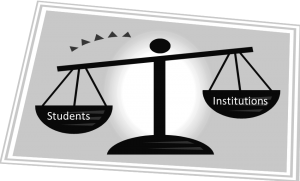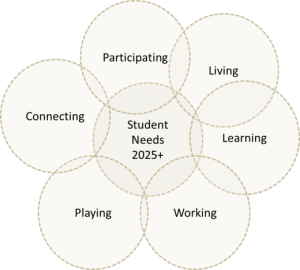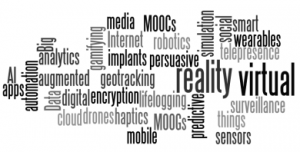We are pleased to release the Final report on The Future of Student Needs: 2025 and Beyond. It has been reformatted to meet the design style of Lumina Foundation.
Today, college students are encouraged to find work-life-school balance. In 2025, such a concept will be obsolete because work, life, school, and play will be one in the same. This is just one of the provocative takeaways that emerged from our Student Needs 2025+ project.

Key themes
Following our Framework Foresight method, we identified baseline and alternative scenarios, which we then analyzed for cross-cutting patterns. Four themes were identified:
1. A shift in balance of power from institutions toward students. The balance of power shifting toward  students means they will increasingly be dictating what needs to be “produced” rather than the institutions doing so.
students means they will increasingly be dictating what needs to be “produced” rather than the institutions doing so.
2. A “blurring” between the six domains that makes them difficult to distinguish and thus difficult to addres s in isolation. As Cody Clark put it, “it’s all play” in 2025. Work, play, and school will all intersect and rely on one another.
s in isolation. As Cody Clark put it, “it’s all play” in 2025. Work, play, and school will all intersect and rely on one another.
3. An emergence of IT/AI technologies that are both parto f the “problem” – that is they drive change – and th e “solution” – that is they offer great potential for addressing student needs. The growing capabilities of a vast array of information and communication technologies are the single biggest driver of change across the six domains. Put simply, in looking at how student life is changing, there is no bigger driver than the growing influence of information technologies
e “solution” – that is they offer great potential for addressing student needs. The growing capabilities of a vast array of information and communication technologies are the single biggest driver of change across the six domains. Put simply, in looking at how student life is changing, there is no bigger driver than the growing influence of information technologies
4. A set of “social” or non-technological issues must be “dealt with” for the alternatives to occur as described. The teams questioned their assumptions and looked for ways that the growing influence of information technology might not happen, and found little to stop it beyond economic collapse. There are social issues, such as personal security in cyberspace or the security of the Internet itself related to technologies that could slow progress, but they are not likely to stop it.
The emerging needs
We generated more than 300 needs using three different approaches that then went through several rounds of combining, modifying and clustering. We separated out historical and current needs and focused on the future, in order to arrive at this final set of nine emerging needs:
- Re-skilling: students need to know what skills they will need and how to master them
- Mentoring: students need personalized guidance on what to do next and on other life lessons
- Continuous and real-time feedback: students need to know how they are doing so they can continuously improve in order to “keep up” and move forward
- Frameworks (for navigating new uncertainties): students need to know what to do in various situations, particularly novel ones
- Credentials: students need to document knowledge, skills and experiences acquired
- Experiences: students need contact with people and the world that teach by doing
- Personalized instruction: students need the means to acquire relevant knowledge and skills customized to their individual style
- Spaces, tools, and templates: students need physical and virtual supportive environments and tools for pursuing and acquiring knowledge and skills
- Differentiation: students need to find and communicate their personal value proposition that distinguishes “who they are.”
There is much, much more. Just a few tidbits to whet your appetite. Andy Hines
